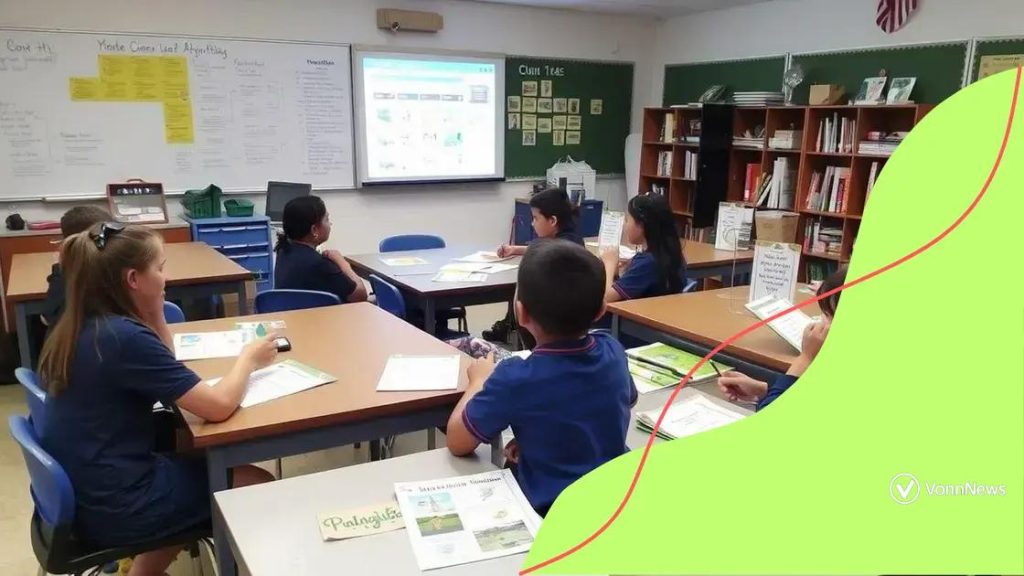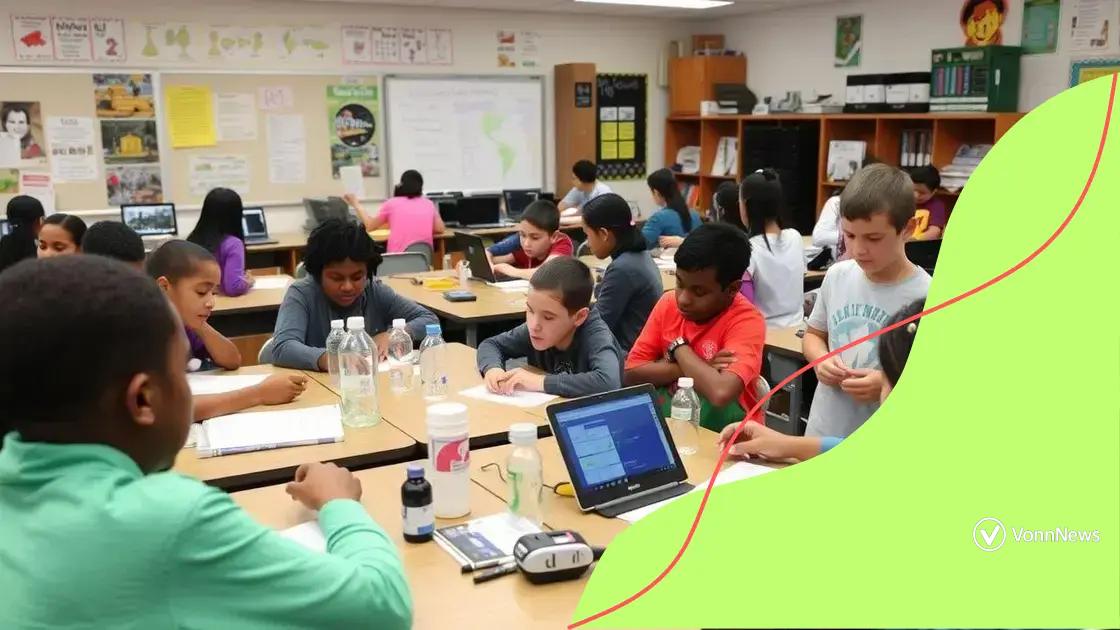Climate literacy in K-12: preparing future generations

Anúncios
Climate literacy in K-12 education equips students with essential knowledge and skills to understand and address environmental challenges, fostering responsible citizenship and sustainable practices.
Climate literacy in K-12 is crucial for helping students understand the challenges our planet faces. Have you ever wondered how well-informed our future leaders will be about climate change? This article delves into the importance of teaching these essential concepts in schools.
Anúncios
Understanding climate literacy
Understanding climate literacy is essential for students in K-12 education. It equips them with the knowledge needed to comprehend climate change and its impacts. By fostering awareness early on, we can ensure future generations are prepared to address environmental challenges.
What is Climate Literacy?
Climate literacy means being well-informed about climate science, including how the climate system works and how human actions influence it. It encourages individuals to engage critically with climate issues and promote a sustainable future.
Key Concepts of Climate Literacy
- The understanding of basic climate science principles.
- The ability to recognize the human impact on the climate.
- The skills to analyze and interpret climate-related information.
- The advocacy for sustainable practices and policies.
Additionally, integrating climate literacy into education allows students to explore real-world problems. For instance, when students learn about climate change, they can investigate local effects on their communities. This hands-on approach makes learning relevant and meaningful.
Teachers can enhance climate literacy by using interactive projects, discussions, and problem-solving activities. Collaborating with local organizations can also provide resources and expertise that empower students to make a difference.
Importance of Climate Literacy in Schools
Anúncios
By prioritizing climate literacy, schools prepare students to be informed citizens. Knowledgeable students are more likely to take action and promote environmental sustainability. They become advocates for policies that protect the planet for future generations.
As we address the challenges of climate change, climate literacy becomes a cornerstone of education. It facilitates conversations about resilience, adaptation, and innovation in addressing environmental issues. Schools have a unique opportunity to shape climate-conscious leaders.
Benefits of climate literacy in schools
The benefits of climate literacy in schools extend far beyond the classroom. By teaching students about the environment, we empower them to make informed choices. When young people understand the implications of climate change, they become advocates for a sustainable future.
Engaging Students
Climate literacy makes learning engaging and relevant. Students who grasp the importance of environmental issues are often more motivated. They can connect lessons to real-world challenges, fostering enthusiasm for learning.
- Realization of their role in combating climate change.
- Increased interest in science and environmental studies.
- Ability to participate in local and global environmental initiatives.
Furthermore, developing a solid foundation in climate literacy can lead to improved critical thinking skills. Students learn to analyze data, question sources, and understand the complexity of climate science. These skills serve them well in other academic areas and life.
Creating Responsible Citizens
Another significant benefit is the fostering of responsible citizenship. Climate-literate students are more likely to engage in civic activities and support environmental policies. They may participate in community clean-up events or advocate for local sustainability projects.
By teaching students about their environment, schools contribute to building a generation that values sustainability. This understanding helps them recognize the need for sustainable practices, both personally and societally. For example, they learn about recycling, energy conservation, and the reduction of waste.
Additionally, climate literacy encourages collaboration among students. Group projects and discussions about environmental topics promote teamwork and communication. This not only enhances their learning experience but prepares them for future collaborative efforts in any field.
Strategies to teach climate concepts

Teaching climate concepts effectively requires a variety of strategies to engage students. Utilizing diverse methods can help make learning about climate change both informative and interesting. By applying these strategies, educators can create a dynamic learning environment.
Hands-On Learning
One effective approach is through hands-on learning experiences. Activities that allow students to participate actively lead to better retention of knowledge. For instance, students can conduct experiments to measure carbon footprints or analyze local weather patterns. This practical application helps them understand the science behind climate change.
- Conducting experiments related to greenhouse gas emissions.
- Creating projects on renewable energy sources.
- Participating in community gardening to learn about ecosystems.
Such experiences often ignite a passion for environmental science, fostering curiosity and deeper understanding. By engaging in these activities, students are more likely to connect their lessons with real-world realities.
Utilizing Technology
Incorporating technology is another powerful strategy. Digital tools can enhance climate education. For example, using interactive simulations allows students to visualize the impact of climate change on different ecosystems. Websites and applications that track climate data can provide real-time insights that keep the learning relevant.
Moreover, online resources can help students explore global climate issues. They can engage with various perspectives through videos, articles, and interactive forums. This not only broadens their understanding but also encourages critical thinking.
Collaboration is key when teaching climate concepts. Group projects and discussions enable students to work together to solve problems and propose sustainable solutions. During these activities, they learn to appreciate diverse viewpoints and develop communication skills.
Connecting to Local Issues
Teachers should also aim to connect climate education with local environmental issues. Discussing relevant topics can help students see how climate change affects their own communities. For instance, examining local pollution sources or conservation efforts inspires students to take action.
Field trips to nearby parks or nature reserves can also reinforce lessons. Observing ecosystems first-hand can greatly enhance their understanding of biodiversity and conservation.
Engaging parents and the community
Engaging parents and the community is vital for promoting climate literacy in schools. When families and local organizations are involved, students receive a more supportive learning environment. This collaboration can significantly enhance students’ understanding and commitment to climate issues.
Importance of Parental Involvement
Parental involvement reinforces the climate concepts that students learn in school. Parents who understand climate issues can support their children’s education at home. They can participate in discussions about sustainable practices, such as recycling and energy conservation. This shared knowledge creates a unified atmosphere where children feel empowered to act.
- Encouraging discussion of climate topics during family activities.
- Participating in environmental clubs or school events.
- Supporting school initiatives aimed at sustainability.
When parents engage, they help create a strong foundation for climate education. This involvement shows children that their learning is important both at school and at home.
Community Partnerships
Building relationships with local organizations can extend climate education beyond the classroom. Community partnerships can provide resources, expertise, and opportunities for students to apply their learning in real-world settings. For example, local environmental groups can offer workshops and resources to enhance curriculum.
These partnerships can also help organize community events, such as tree planting or clean-up days. These activities not only benefit the environment but also foster teamwork among students and community members.
Additionally, inviting guest speakers from the community can inspire students. Experts in environmental fields can share their knowledge and experiences, making climate issues more relatable and urgent.
Creating Awareness
Schools can engage parents and the community by holding informational sessions about climate change and its impacts. By hosting workshops or seminars, schools provide a platform for discussing local environmental issues.
Creating awareness initiatives, such as newsletters or social media campaigns, can also keep families informed. These tools can include tips for sustainable living and updates on school projects related to climate literacy. When parents and community members are kept in the loop, they are more likely to participate actively in supporting climate education.
Real-world applications of climate education
Real-world applications of climate education help students understand the importance of sustainability. When students see how their learning connects to everyday life, they become more engaged and see the relevance of their education.
Understanding Local Impacts
Students can explore the effects of climate change in their own communities. They can conduct projects that involve examining local environmental issues, such as air quality or water pollution. This hands-on approach allows them to gather data and identify patterns.
- Monitoring local weather changes over time.
- Analyzing the impact of urban development on natural habitats.
- Conducting surveys on community recycling habits.
By understanding the local impacts, students develop a sense of responsibility toward their environment. They become advocates for change, able to identify specific actions that can help improve local conditions.
Participatory Projects
Participatory projects provide an opportunity for students to engage with their community actively. Students can collaborate on projects like community gardens, where they learn about biodiversity and sustainable practices. These projects promote teamwork and allow students to apply their knowledge.
Additionally, involving students in local climate initiatives can enhance their learning experience. Students can work with organizations to create awareness campaigns, organize clean-up drives, or assist in tree plantation drives. Through these activities, they experience the impact of collective action.
Using Technology for Climate Education
Students can also leverage technology to gather information and promote climate awareness. They can use apps or websites to track energy consumption and carbon footprints. This kind of technological engagement makes the learning experience more interactive and relevant.
Moreover, students can participate in virtual programs or workshops with experts. These experiences help them connect classroom learning with real-world solutions, fostering critical thinking.
Through these real-world applications, students not only learn about climate concepts but also develop skills that will serve them in the future. They learn to think critically, collaborate effectively, and take action, preparing them to be responsible global citizens.
In conclusion, climate literacy in K-12 education is essential for preparing students to face global challenges. By understanding climate concepts, students become more engaged and responsible citizens. They are equipped with the knowledge to make positive changes in their communities. Hands-on projects, parental involvement, and community partnerships enhance learning experiences and create lasting impacts. It is crucial to foster a generation that values sustainability and takes action for our planet’s future.
FAQ – Questions about Climate Literacy in K-12 Education
Why is climate literacy important for students?
Climate literacy helps students understand environmental issues and prepares them to be responsible citizens who can actively participate in sustainability efforts.
How can parents get involved in their children’s climate education?
Parents can support climate education by discussing environmental topics at home, participating in school activities, and advocating for sustainability initiatives.
What are some practical applications of climate education?
Practical applications include hands-on projects, community initiatives, and local environmental assessments that allow students to connect classroom learning to real-world situations.
How does technology enhance climate education?
Technology enhances climate education through interactive tools, simulations, and access to data that make learning more engaging and relevant for students.